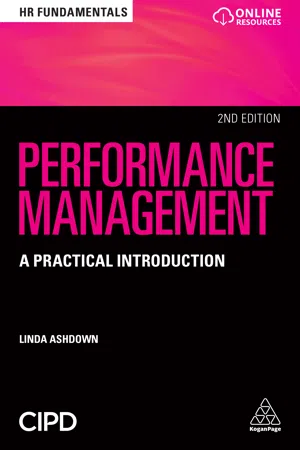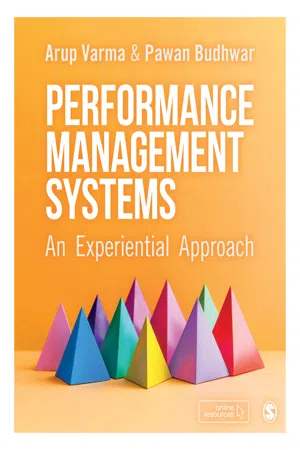Business
Performance Management
Performance management involves the process of setting goals, assessing progress, and providing feedback to employees to improve their performance. It encompasses regular performance evaluations, coaching, and development planning to ensure that employees are meeting organizational objectives and continuously improving their skills and capabilities. Effective performance management contributes to overall business success by aligning individual performance with organizational goals.
Written by Perlego with AI-assistance
Related key terms
9 Key excerpts on "Performance Management"
- eBook - ePub
Performance Management
A Practical Introduction
- Linda Ashdown(Author)
- 2018(Publication Date)
- Kogan Page(Publisher)
Performance Management is made up of many activities that when managed holistically can lead to effective people management. The particular challenge of providing a clear, comprehensive definition of Performance Management is that it covers such a breadth of activities. It is also difficult to define precisely as the nature of Performance Management will and should vary according to the organization context. The sector, structure, size, culture, strategy and leadership of the organization will all influence the nature of Performance Management. One of the most often used definitions is that of Armstrong (2009): ‘Performance Management is a systematic process for improving organizational performance by developing the performance of individuals and teams.’ One of the reasons this definition has proved so popular is because at its heart is the crucial issue of the link between the performance of an organization’s human resources and the achievement of organization goals. ‘Alignment’ is a key ingredient in successful Performance Management systems: the alignment of an individual’s performance to the goals of the organization.A senior director I worked with in the advertising industry once told me that he regarded effective Performance Management as having an invisible thread linking the organization’s mission statement to the performance objectives of the individual – and that image has stayed with me both in my practice as an HR professional and when teaching human resource management (HRM) to others. I firmly believe that the core principle of everyone working for an organization having a clear understanding of how they contribute to the mission, vision and goals of the organization is an important one. There is a real benefit to the organization of having all the people who work for it focused on the right things to add value. There are also clear benefits for the employees of that invisible thread being in place. For example, the intrinsic satisfaction of feeling significant, understanding their contribution and ultimately feeling valued by the organization – that invisible thread helps to deliver that understanding and those feelings. This is a powerful enabler for retaining staff and supporting them to deliver high-performance outcomes. Individuals are much more likely to ‘go the extra mile’ for those organizations where they understand and value the organization’s goals and believe that they can contribute to the achievement of those goals and will be valued for doing so. Unfortunately, in many organizations that connection between the organization’s goals and individual contribution is either weak or missing altogether; this has the potential to impact detrimentally on both the performance of the individual and that of the organization. - eBook - ePub
People Practice
A Complete Guide
- Karen Waite, Kathy Beevers, Nicky Small, Keith Tomlinson, Shazad Hussain(Authors)
- 2021(Publication Date)
- CIPD - Kogan Page(Publisher)
Performance Management could be said to be about doing the right things as well as doing things right. It is about ensuring that employee efforts are focused on activities that will fulfil organisational goals, and that those activities are carried out to the required standard.This, and all the benefits listed above, would be considered desirable by most organisations and their employees, and so it is not difficult to understand why almost all organisations attempt to implement some form of Performance Management system.Meanings and definitions
Performance Management
The term ‘Performance Management’ is used in a number of different ways, often depending on people’s experience of it. Consequently, for some, ‘Performance Management’ is an overarching term which covers the full spectrum of people management, from induction through to allocating work, agreeing performance objectives, monitoring work, informing reward decisions, managing poor performance and recognising high performance. However, for those at the other end of the scale, ‘Performance Management’ can simply refer to an annual appraisal event.In many ways, Performance Management has evolved from an earlier management approach known as ‘management by objectives’ (MBO). MBO, popularised by a number of management gurus, most notably Peter Drucker (1954) and John Humble (1972) has an emphasis on goal setting and ensuring that goals are firmly aligned across the whole organisation. Organisation goals are cascaded downwards into team objectives, which in turn cascade into individual performance objectives. Performance is then closely monitored and measured, with individual performance outcomes feeding back up into team outcomes and ultimately into the achievement of organisational goals.While MBO promoted worker agreement and some ownership of objectives, the tight management controls involved conflicted with the gradual shift towards greater worker autonomy and self-regulation. The approach was also sometimes criticised for taking insufficient account of the different factors, other than worker performance, that can affect the extent to which organisational goals are achieved. - eBook - ePub
Managing People
A Practical Guide for Front-line Managers
- Rosemary Thomson, Eileen Arney, Andrew Thomson(Authors)
- 2015(Publication Date)
- Routledge(Publisher)
• It is strongly associated with development and especially identifying what development is needed.At one level Performance Management is strategic in that it is concerned with integrating the different dimensions of an organisation’s operations into its wider objectives, but it is also concerned with the role of the individual manager and, indeed, expects responsibility to be shared by all members of the organisation. The integration is primarily vertical, aligning organisational, team and individual objectives, but can also be functional, bringing together functional strategies in different parts of the organisation and within functions, such as integrating different aspects of managing people.The aim of Performance Management is continuously to improve the performance of individuals and that of the organisation. It involves making sure that the performance of employees contributes to the goals of their teams and the business as a whole. The system is operated on an annual cycle which evaluates the past, sets future objectives, plans for the development needed to achieve those objectives, and potentially links to a framework of rewards, whilst there is also an ongoing record of progress and constant feedback on performance. This annual cycle is central to the whole concept of Performance Management, which has four distinct stages, although the review and the plan stages are usually carried out at the same time through the appraisal system, whilst the develop and perform stages are carried out continuously throughout the year. - eBook - ePub
Armstrong's Handbook of Performance Management
An Evidence-Based Guide to Performance Leadership
- Michael Armstrong(Author)
- 2022(Publication Date)
- Kogan Page(Publisher)
15Managing organizational performance
Introduction
The management of organizational performance is the continuing responsibility of top management who plan, organize, monitor and control activities and provide leadership to achieve strategic goals and satisfy the needs and requirements of stakeholders. Individual and team Performance Management systems as discussed elsewhere in this book play an important part. But they function within the context of what is done to manage organizational performance and to develop effective work systems.Managing organizational performance is a complex business that is examined in this chapter under the following headings:- The process of managing organizational performance.
- The strategic approach to managing organizational performance.
- Business Performance Management systems.
- ProMES.
- Organizational capability.
- Performance Management and human capital management.
- Measuring performance.
The process of managing organizational performance
Gheorghe and Hack (2007) observed: ‘Actively managing performance is simply running a business – running the entire business as one entity. It’s a continuous cycle of planning, executing, measuring results and planning the next actions. In the context of a larger strategic initiative, that means continuous improvement.’ They noted that:The fundamental problem managers face as they make day-to-day decisions is an inability to link their actions to key performance measures. What managers need is more enterprise intelligence, actionable information that enables them to know where their problems are, in real time, know who their key performers are without combing through a stack of reports, know where their company is at risk, before the numbers turn bad, and, most of all, know which process could improve performance.The management of organizational performance is a strategic approach that has to take account of the needs of multiple stakeholders and makes use of business Performance Management systems. Sink and Tuttle (1990) stated it includes five dimensions. - eBook - ePub
Effective People Management
Your Guide to Boosting Performance, Managing Conflict and Becoming a Great Leader in Your Start Up
- Pat Wellington(Author)
- 2017(Publication Date)
- Kogan Page(Publisher)
07Performance Management
Introduction
Performance Management is helping a member of your staff understand their role and responsibilities, and their individual contribution to realizing business objectives through achieving planned and agreed results. Many organizations also use Performance Management in career planning and personal development.What does a member of staff expect from their manager?- Where the team and individuals are headed. This is the business vision.
- Why they are headed there (and not somewhere else). This is the business mission or why the organization exists.
- What it looks like when they get there. How our objectives and efforts help us to deliver the organization’s mission and business plans.
- How we should behave and work together as a team. This is all about the organization’s culture.
So if you are recruiting someone into your team, jointly agree with them what you expect (and do not expect from them) in terms of performance and behaviours. This is where key results areas (KRA) and targets are required.Key results areas flow from individual or team job descriptions. KRAs contribute towards clarifying how we should (as a team) be spending our time . For the team’s strategy to succeed all team members must achieve specific results, which when accumulated, ensure that all strategy elements are delivered. KRAs are a summary of those key factors of an individual’s job or the team’s job that are vital for the team’s success. They must be monitored, at a minimum, each month to ensure keeping on track with your strategy.If you have difficulty identifying your KRAs ask yourself the following question: ‘What are the major aspects of the team’s work that could go wrong?’ You might say ‘We don’t realize our sales target’, ‘We use up our resources’, ‘Too many customers complain’ or ‘We don’t complete our reports on time’. These can be translated into the following KRAs – sales, finance, customer service and monthly reports. - eBook - ePub
Talent
Making People Your Competitive Advantage
- Edward E. Lawler(Author)
- 2010(Publication Date)
- Jossey-Bass(Publisher)
An effective Performance Management system needs to accomplish four things. First, it needs to define and produce agreement on what type of performance is needed. The bedrock of any Performance Management system should be agreement on what needs to be done and how it should be done. Without a clear definition of what kind of performance is desired, it is impossible to develop and motivate individuals who can meet or exceed performance standards! It also is key to guiding the performance of individuals so that it supports the organization’s strategy and plans.Second, it needs to guide the development of individuals so that they have the skills and knowledge needed to perform effectively. To be effective, a performance-management system needs to help employees gain the skills and knowledge they need if they are to perform effectively.Third, it needs to motivate individuals to perform effectively. Even the best talent will perform at a high level only if motivated to do so. When it comes to performance, high levels of both talent and motivation are needed.Finally, it needs to provide data to the organization’s human capital information system. It needs to be a primary source of information about how individuals are performing and what skills and knowledge exist in the workforce. This information is a critical input to succession planning as well as to strategic planning.In this chapter I look at the first three objectives, then discuss Performance Management system design and pay-for-performance systems. Chapter Six will take up the fourth objective, providing talent management information.DEFINING PERFORMANCE
Every Performance Management system in an HC-centric organization should include the explicit identification of what needs to be achieved and how performance will be measured. HC-centric organizations don’t have bureaucratic control systems and detailed job descriptions, thus, without an effective Performance Management system there may be ambiguity about what each individual should do and what constitutes effective performance. - eBook - ePub
Reinventing Talent Management
Principles and Practices for the New World of Work
- Edward E. Lawler(Author)
- 2017(Publication Date)
- Berrett-Koehler Publishers(Publisher)
The key to decisions with respect to what the right behaviors are to measure and what segments to create should primarily be driven by what is measureable and how frequently and in what way the key organizational outcomes can be measured. To some degree this will be determined by the activity that is being examined and by the hierarchical level that is the focus of Performance Management activities. Also important are the skills of managers and the kind of technology that can be utilized.Performance Management judgments and evaluations need to become much more data-and evidence-based. Data also need to be gathered on how effective an organization’s appraisal systems are, on what is working and what is not working, and on how well individuals are actually carrying out the appraisal process. The Performance Management process is too important a process to be left to chance; it needs to be based on evidence of effectiveness and supported by an ongoing measurement system that focuses on how it is being implemented and is impacting performance.Overall, Performance Management is an area that requires major changes to be effective in the workplace of the future. It has not been effective in the past, and it is only going to be less effective if the same practices that have been used for decades continue to be used. A thoughtful data-based Performance Management system is badly needed in most organizations. Given the technology and knowledge that is currently available, it is possible that effective Performance Management systems can be designed and utilized by organizations. Because of the nature of the current workplace and workforce, Performance Management has never been more important than it is today, and it has never been so possible to do it effectively. - eBook - ePub
Performance Management Systems
An Experiential Approach
- Arup Varma, Pawan Budhwar(Authors)
- 2019(Publication Date)
- SAGE Publications Ltd(Publisher)
1 Performance Management in Context Arup Varma Pawan S. BudhwarChapter Learning Objectives
- Understand how the concept of work has evolved over the years
- Understand the critical role of the Performance Management process in managing work
- Understand why PM can and should be modified but not eliminated
Chapter Skill Objectives
- Learn how to tell the difference between PM and PA
- Learn why rater training is a critical part of an effective PMS
- Learn about the different components of an effective PMS
Introduction
Ever since the first humans decided to lift and move stones, there were others telling them what to do, how to do it and sometimes, why they were doing what they were doing. Of course, there were others ready to criticize how the work was being done. In other words, while Performance Management (PM) may have emerged as a formal discipline only in the last century (see DeNisi & Murphy, 2017), we believe that the art of PM has been around forever. Of course, PM has evolved over the centuries, and continues to evolve – over the decades, for example, we have seen the emphasis shift from manual work to knowledge work, reflecting the shift from a manufacturing economy to a knowledge economy, etc. Similarly, for some time now, the discussion has centered around how some human beings will soon be replaced by robots in the workplace, and how human resource (HR) systems need to catch up and make required adjustments accordingly. Ironically, if robots did start to populate the workplace in large numbers, PM would be the key HR system that would have to be vastly re-engineered along with employee relations, since robots would still have some human supervisors, subordinates, and colleagues. What is ironic, however, is the fact that with almost amazing regularity, one reads in the popular press that some well-known organization has decided to get rid of its PM system, replacing it with one-on-one feedback and supervisor–subordinate conversations. Of course, what the organizations are unintentionally admitting is that they don’t do a good job of PM, and that this is what led to the decision to get rid of it, or modify it substantially – such as, getting rid of the numerical scales, and replacing those with some other form of evaluation, such as ranking. - eBook - ePub
- Stewart Liff(Author)
- 2007(Publication Date)
- AMACOM(Publisher)
CHAPTER 5 Performance ManagementPrinciples A performance appraisal system is designed with three overriding principles in mind:1. To align and communicate organizational goals2. To improve organizational, group, and individual performance by holding everyone accountable3. To serve the customerThe better the system achieves all three goals in an integrated manner, the more effective the organization will be. Let’s look at each principle in greater detail.Many organizations make the mistake of rarely explaining what their performance goals are. They may include them in a report or in a chart, but that information rarely cascades down to the individual employee.The most effective way of doing this is to first ensure that there is a clear line of sight from the organization’s goals down to the individual’s performance standards. This is essential because if the performance goals are properly aligned with employee and team performance standards at all levels of the organization, everyone will be working toward achieving the organization’s goals.Once the standards are aligned, they must be written in a manner that is clear, understandable, fair, measurable, and achievable. Last, the employees need to understand how the standards relate to the organization’s goals, so they recognize how their actions fit into the bigger picture. This should be accomplished using the whole brain method of teaching described earlier in this book.Several years ago, I worked for a national organization whose productivity had declined. In order to address this situation, national productivity goals were established, and goals were given to every office. Each director had a productivity goal written into his performance standards, as did each division chief, each team, and each employee. Everyone understood the goals, why they were important, and how they fit into the national picture. The net result of this unified approach was that national productivity increased almost immediately, and continued at a high rate.
Learn about this page
Index pages curate the most relevant extracts from our library of academic textbooks. They’ve been created using an in-house natural language model (NLM), each adding context and meaning to key research topics.








